Michelle’s Review: This article is full of great information about what to do when encountered with wildlife, yet an entertaining read at the same time.
__________________________________________________________________________
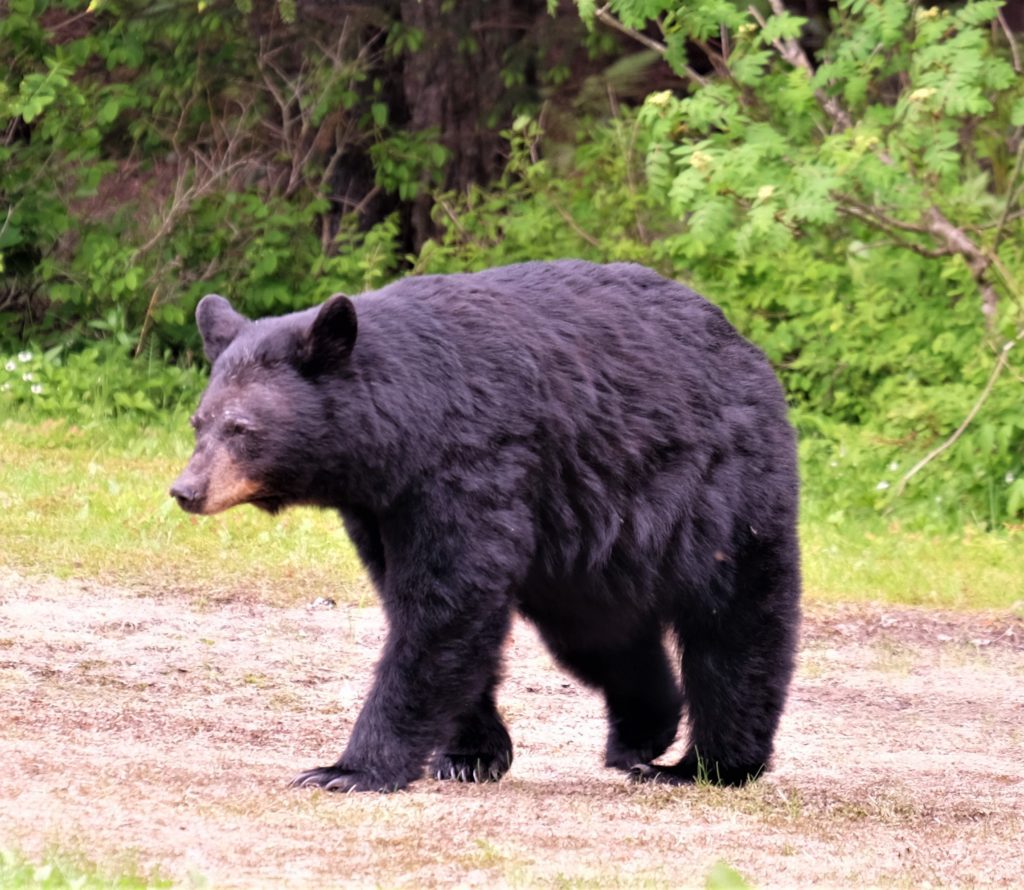
My friend Carol had to take her mother to the emergency room. Not to worry, everything’s ok. While in the waiting room she met a man who literally wrestled with a bear in his front yard, punching it in the face and yelling until the bear let him go. This was not the first time I had heard of human-bear encounters in the city of Asheville, but I do believe it was a prime example of my worst nightmare. Our neighbors were gardening in their front yard when a bear came lumbering between the houses directly across the street! They retreated until it went away. We met our nearby neighbor Lorraine while we were strolling through the neighborhood. She was walking her dog Winston and she was carrying an electric cattle prod! It’s kind of like a taser, but on a long pole which delivers a nasty charge. A bear had once provoked Winston, a dog with a tendency to protect. They got away from the bear, but since that time, she walks her protective pet while carrying a weapon that, if deployed, could be annoying enough to cause a bear to scamper away. Or perhaps it would simply piss off the bear and then you’re pretty much out of options. Apparently punching it in the face works if you’ve got a good reach. ER visit to follow.
According to Asheville City Source, black bear attacks on humans are rare, but they do happen from time to time. Bearwise, a webpage about bears, safety and more bears, states that there are anywhere from 17,000 to 20,000 black bears in the state of North Carolina, the largest collection of live bears in the south. My chances of running into one seem to be quite high. This does not appeal to me at all. Sure, I love the mountains and Asheville is a cool city but I do not (repeat: DO NOT) want to come face to face with a bear in my yard, in my neighborhood, on the hiking trail or walking down Biltmore Ave.
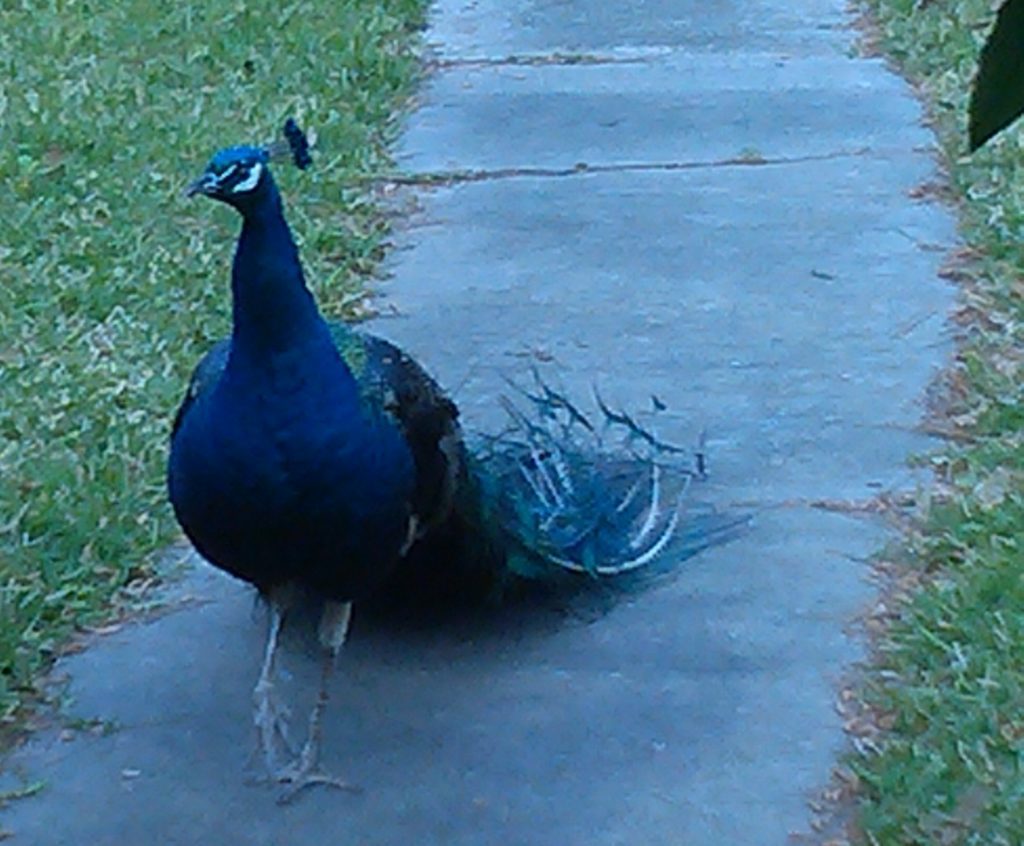
Urban wildlife encounters are not a new experience for me. Our former neighborhood in Houston, the 4th largest city in the country, was next to the bayou, a corridor through which flowed rainwater and runoff, and provided shelter for countless birds, rodents and predator species. We and our neighbors experienced frequent sightings of critters including turtles, armadillos, rabbits, alligators, peacocks, herons, coyotes, opossums and owls. Ok, only one alligator and that was after the flooding from Hurricane Harvey. Coyotes are considered the nuisance species in the neighborhoods along the bayou.
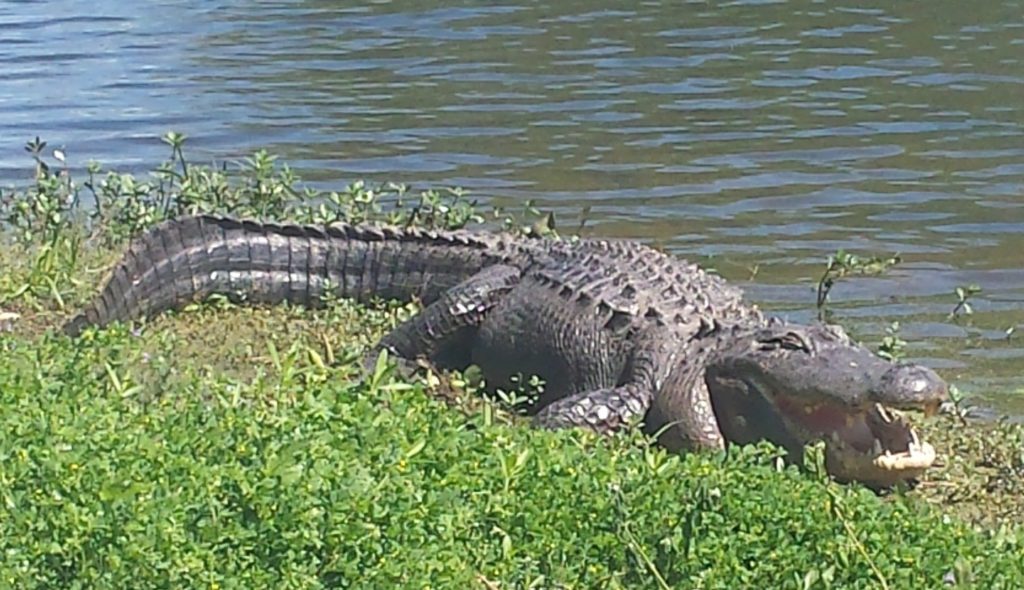
Never approach or feed alligators.
Photo taken at Brazos Bend State Park, a safe haven for alligators but not small dogs!
According to Matt Palmer in his article Valuing Urban Wildlife: Critical Partners in the Urban System or Scary, Disgusting Nuisances, coyotes are one of the most adaptable species (much like certain birds, i.e. pigeons) for living in urban centers as long as there are parks and other natural landscapes for cover. They have no natural predators in the city, are mostly nocturnal and help to keep the rodent populations in check. They also tend to have the annoying habit of eating our pets and, much like dingoes, (according to Wikipedia), are capable of attacking and eating a small child.
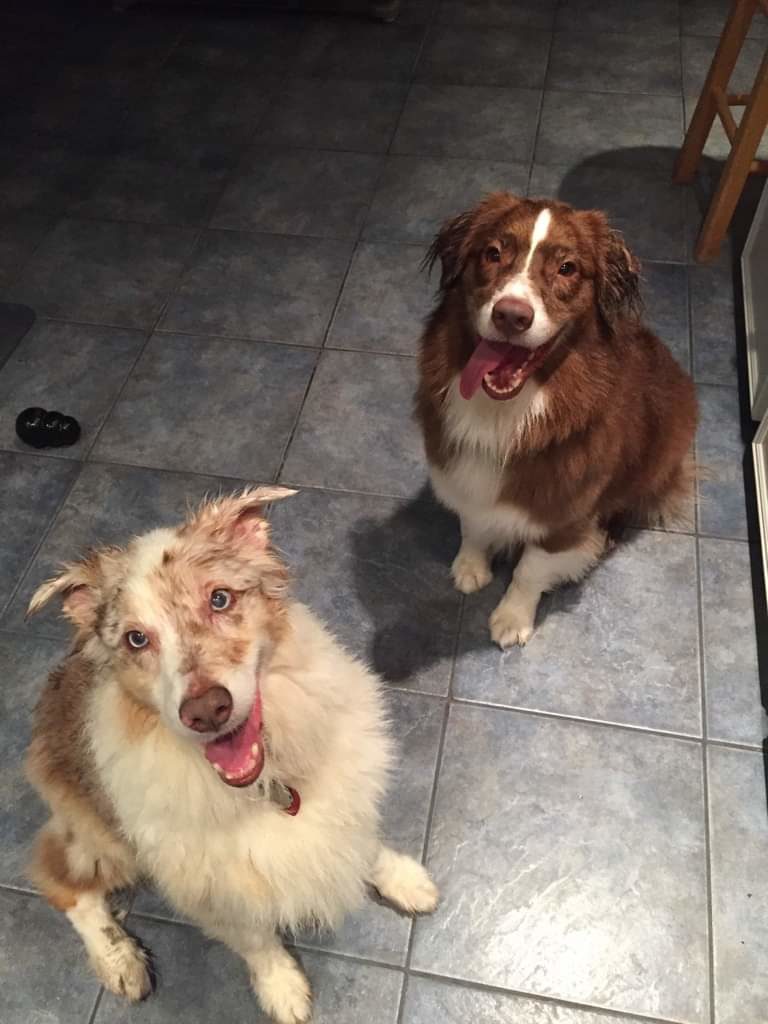
My Houston friend Martha lives near the bayou and has twice encountered coyotes while walking her dogs in the morning. Much of the wildlife along the bayou had been displaced by the flooding caused by Hurricane Harvey and coyote sightings had increased in the area. Her biggest concern was for her dogs. The coyote of the second encounter was as tall as her pets and outweighed them. The older dog, Bailey, Martha states, would have been useless, vulnerable in any attack as she is the dog who is equal parts decoration and comic relief. Her younger dog Louie is something of a wildcard, whose behavior is unpredictable. The coyote was in the process of stalking a cat, a fact which kept Louie focused on the prey, ignoring the predator. Martha coughed to get the coyote’s attention and then shouted “GO HOME!” as was her practice whenever threatened by a stray dog. The coyote obliged perhaps agreeing that was its best option and retreated down the opposite side of the street away from the threat of being outnumbered by this formidable trio.
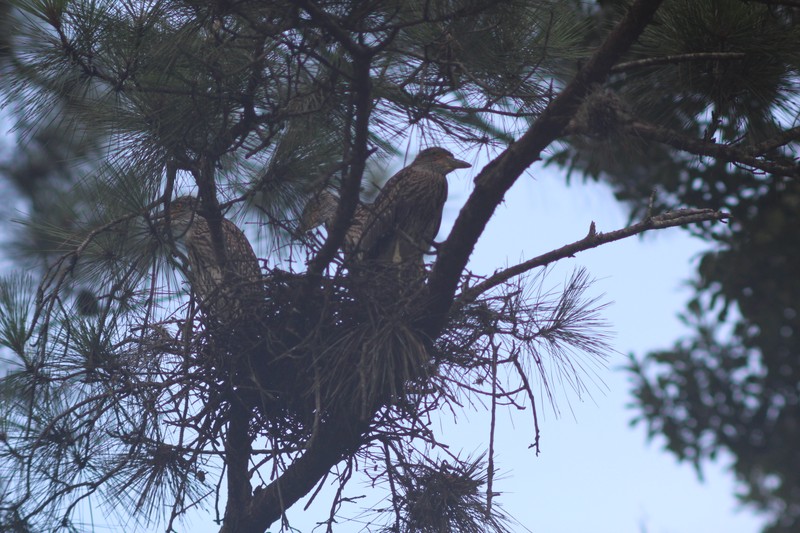
Not all wildlife poses a threat to humans and their pets. Our yard in Houston, near the bayou, was for three years running, the nesting site of a family of yellow-crowned night-herons. Yellow-crowned night-herons are not tiny birds, adults can be up to 27 inches tall (allaboutbirds.org). My husband discovered them one day when he noticed the Buddha statue in our garden was sporting a venerable coating of bird shit. Looking up, he spied the nest. If you want to discover wildlife, know their pooping habits. Recognize the size and ferocity of the species by the size and shape of their leavings. This advice could save your life or lead you to a really cool discovery. Bears…birds.
One night, while we were lounging in front of the TV, ear-piercing screams echoed through the neighborhood. Some creature was trying to invade the nest! Big Bird was having none of that, making a racket more horrifying than the zombie invasion in which we had recently been engrossed. After the baby herons hatched, the noise from the nest was continuous though not so heart-stopping as The Night of the Invasion. Squawking, little tufted heads could be seen peeking over the sides. Eventually, full baby- bird bodies roosted on top of the nest. Finally, just before vacating their temporary home, the chicks emerged from the nest, flying to nearby pine branches to test their wings and survey their terrain. Cute, just don’t stand underneath them.
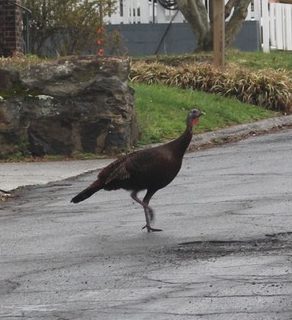
In Asheville, our backyard wildlife sightings have been just as exciting and unexpected as an alligator in the bayou. Most recently, I spied a stately turkey strolling through my front yard. Like a member of the paparazzi trying to nab a photo of an elusive starlet, my husband chased the poor thing all through the neighborhood trying to get some pictures of it. On a neighborhood walk, in a scene out of Alfred Hitchcock’s The Birds, my husband and I timidly, and with great trepidation, passed a tree overflowing with squawking crows, a sound which we could still hear from many blocks away! Probably not a real threat, but a virtual visit to Bodega Bay—I didn’t know where my phone-booth refuge could be found should these birds suddenly disperse!

If you are lucky, you live in a well-planned city that has created space for a variety of animals that bring beauty, delight and nature right to your doorstep. Matt Palmer (thenatureofcities.com) explains that these wildlife citizens of the city provide biodiversity and ecosystem services such as pest control and pollution clean-up along with recreational, aesthetic and spiritual value. There is a variety of emotional responses we humans have to finding out that our cities are treasure troves of wildlife. We either love it for the beauty and wonder or hate it for the noise and nuisance and sometimes feel a mixture of the two. Garden thieves really get our goat, especially if it is goats!, which would be different, but it is usually those damn squirrels (rats with fur) that cause us to sputter, shake our fists and curse loudly. I can tell you from experience that this is not a deterrent. Deer and other magnificent species seem hell-bent on eradicating the landscaping we so lavishly and expensively installed. A deer in the backyard may be a mystical experience or an anger-induced headache.
Certain species pose the threat of attack and injury or death but there are measures we can take to avoid tragedy and/or peeing our pants.
Bearwise provides tips such as never approach or purposely feed bears, secure your garbage, remove outdoor pet food (and small pets at night) and clean your grill to keep bears from trespassing in the search for human food. I follow these rules with zealous ferocity. While I’m securing the garbage, I chant No Bears, No Bears. I’m pretty sure this works as I have not seen one in the yard yet. Although my heart stopped momentarily when I spotted a particularly large groundhog. I will add that should you live in an area visited by potentially dangerous wildlife, never leave your tiny youngsters unsupervised outdoors. These suggestions work just as well for coyotes (and dingoes).
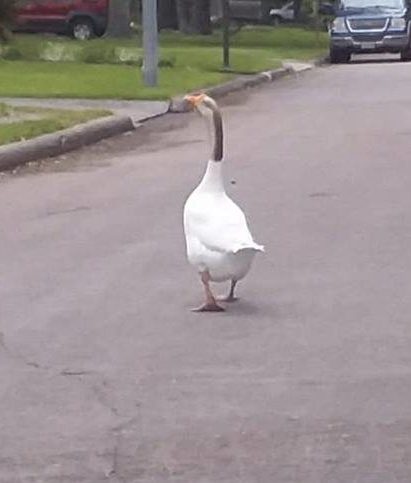
goose in the road
The humans are taking over!! expanding into territory once the realm of majestic animals and also small rodents and slimy frogs. As we expand our own territory, we displace the wildlife that once lived there. Often, we purposely create green space for our own enjoyment, which serves as home to all the plants and animals able to adapt to our encroachment. As my friend Martha states, “We don’t always get to choose what Nature brings us.” We too must adapt and learn to coexist with the creatures sharing our real estate. We don’t always invite them and we think we can live without them but with the proper precautions, we learn to appreciate that they are just as essential to our urban lifestyles as big box stores and Uber drivers. To live without them would mean a city that is just a wasteland of concrete and steel—with no soft edges to dull the hardness of life. If now you are feeling the love, you may want to go outside and explore the neighborhood, plant a few trees or watch for armadillos along your city’s urban paths. Our precious wildlife needs your protection. Just remember it’s never safe to hug a bear.
Ooh baby it’s a wild world,
Cheryl
Guest Editor Michelle and I met at Battery Park Book Exchange and Champagne Bar (they have seriously delicious cookies) at a coffee meetup. I feel she is a kindred spirit as she has a dog and knows some words in Sanskrit. She is also a writer and helpful editor.




No bears….. here….. thank g-d.
Thanks for tip for finding bird nests. The birds love our yard but no nests that we’ve seen!
Some birds’ nests may not be as obvious as a heron’s due to size and squawking! Smaller birds love eaves and nooks, as do I.
Somehow I missed this blog and didn’t see it until today. I love your take on sharing our space with wildlife — I would absolutely hate living in ” . . . a wasteland of concrete and steel . . .” My favorite line: “If you want to discover wildlife, know their pooping habits.”
I’m afraid of bears!